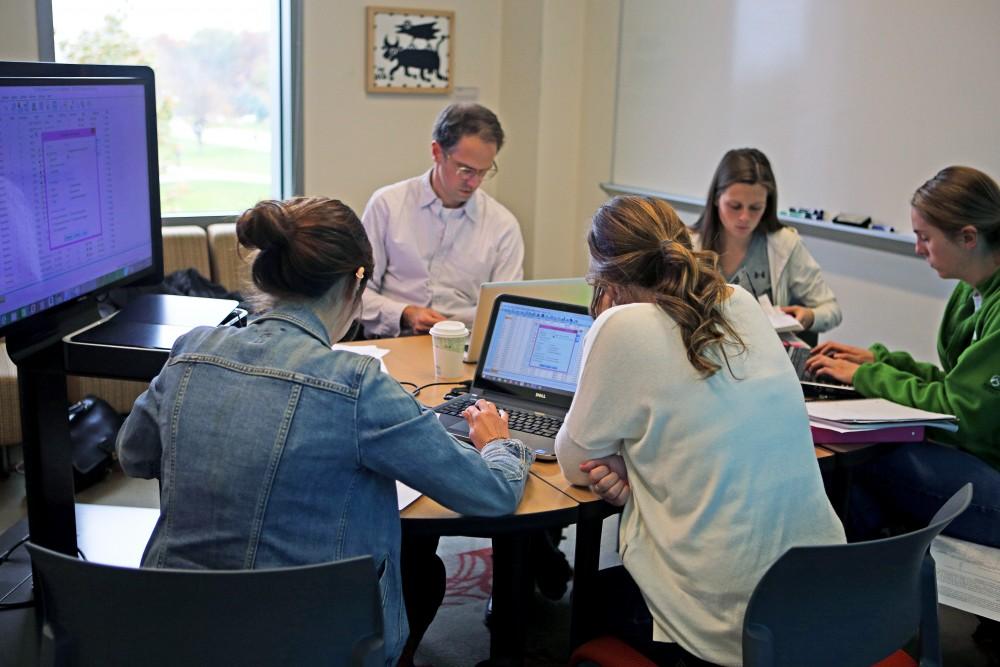New data inquiry lab opens on campus

GVL / Emily Frye Associate professor of political science, Whitt Kilburn, assists some students in the data inquiry lab on Oct. 20th.
Oct 22, 2015
In an effort to help students apply statistical concepts to courses outside of the statistics field, Grand Valley State University recently opened a new student resource center called the Data Inquiry Lab (DIL) to advise students one-on-one with such issues.
Located in Room 135 of the Mary Idema Pew Library, the DIL was created in partnership between the library and the faculty in the political science and statistics departments. The DIL’s staff includes Whitt Kilburn, associate professor of political science; Gerald Shoultz, associate professor of statistics; and Dylan Zwier, M.S. candidate in biostatistics.
While other student resources such as the Statistics Consulting Center and the statistics department tutoring center already exist on campus, the DIL differs from both of these.
Kilburn said the Statistics Consulting Center deals with more in-depth statistical problems while the Statistic Tutoring Center is aimed at students who need help with particular statistics classes.
In the DIL, however, Kilburn said the emphasis is on helping students outside of the statistics department apply statistical skills such as quantitative data management, visualization and analysis into to their work and projects.
“Most of the students who come in here tend to be from the social science departments: psychology, political science or sociology,” Kilburn said. “We also have inquiries from students at the business school. For the most part, the students have been in those cluster of departments.”
Kilburn noted a couple possibilities in which students can use these statistical concepts in other classes.
“Students can use statistics in a class on exercise sports science in which they’re looking to compare hurdling times in indoor versus outdoor tracks,” he said. “A student could also be analyzing data from a social survey in a political science or sociology class. If you need some help remembering how to do these analyses, we can help you with that.”
In addition to one-on-one consulting, the DIL is also developing online content as well as workshops to further develop students’ understanding of specific concepts.
Rather than developing new and original content, Shoultz said the online content is being developed to direct students toward the most helpful, existing resources online.
“There’s already so much stuff on the web, so why reinvent the wheel?” Shoultz said. “A lot of the online content will be quick links to things that will be helpful for students. Instead of scrounging around and wondering what’s good, students will have somebody giving them suggestions to start with.”
Tentatively scheduled to start sometime during the fall semester, Kilburn said these upcoming two-hour workshops will focus on topical issues pertaining to quantitative data analysis.
“We hope to cover some topical things, such as explaining multiple regression analysis or covering some of the more commonly used tools in data analysis,” he said. “These would be tools that students have already had some exposure to through stats 215 but need additional help in applying them to research projects and other classes.”
With only two months into operations, Kilburn said he hopes the DIL will build a campus infrastructure to support student coursework and research in quantitative data.
“Our approach in the DIL is to provide encouragement, advice, and tools for students to complete the work on their own,” he said. “From my perspective, building an infrastructure on campus to support quantitative data is important. By focusing on practical skills and a DIY ethic among students, the DIL complements the consulting service of the Statistics Consulting Center and the Statistics department tutoring center.”
For more information on hours of operations and upcoming workshops, go to www.gvsu.edu/datainquirylab.

























